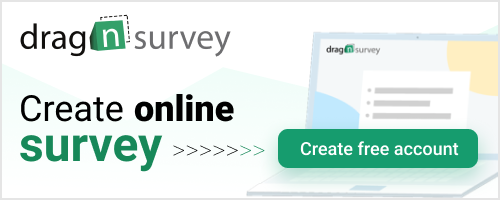Many businesses and survey builders use a rating scale to determine the opinions of respondents. There are many benefits of this. Firstly, it is quantitative data that is fairly easy to monitor and analyze. Therefore, you can get results quickly and make changes based on the feedback you receive.
Scale systems are also easier for audiences to understand and improve survey retention. This means you can get more people to complete your survey and you can get better, more accurate results from a larger population.
>> Create your Online Survey with Drag’n Survey, click here

The Problems With Rating Scales
However, rating scales aren’t perfect. Sometimes they can be ineffective. Most of the time, this is because the creator of the survey hasn’t designed them for purpose. There can be various impacts. Firstly, it can mean that data can become corrupt, misleading and almost worthless. This wastes time, resources and money. If you have to re-do the survey, this can annoy your audience as well.
If you don’t realize the problem soon enough, this can cause another problem: you taking action in the wrong area or direction. Imagine if you’re asking someone what they thought about their delivery and request a rating of between one and five, and they put two, thinking that you’re talking about delivery speed, but you meant the condition of goods received. You might wonder what happened to the goods during transit.
There are several ways through which, inefficiencies within the rating scale can take place. So, here are some of the more common design flaws in the system, and what you can do to improve it so you can get better responses from your audience.
1. Stop Having A Neutral Position On The Rating Scale
One of the biggest mistakes survey creators make, is that they have a middle option on the scale. This is often a ‘neither like/didn’t like’ or ‘neither positive/negative’. The problem with this, is that it offers little value to the results. Those who have no interest in the survey, will also just enter the neutral option for a lot of questions. Therefore, you can have a lot of skewed data.
Another problem is that most people don’t have a neutral experience or opinion. Most times, experiences are either slightly one way or another. Therefore, audiences should be made to commit. If the question doesn’t apply to their experience, then a neutral position really isn’t a great option either as it suggests that they did experience it. Therefore, never have a neutral opinion, just have a slightly positive or slightly negative one.
There should be an option that states ‘not applicable’ for those people who can’t comment. To avoid someone just placing not applicable on lots of answers, have a threshold that removes all their responses if someone responds with this answer too often.
2. Keep The Same Rating Scale Throughout The Survey
Another common problem is when designers constantly change the rating system. For one question it could be out of 10, another time it could be out of five. This is confusing to audiences. They prefer to have a rating that is consistent throughout the process.
Therefore, consider how much detail you would like to go in to, right from the beginning of your survey. The more detail, the larger the scale needs to be. If you’re trying to benchmark some aspects (such as in an employee survey), a larger scale can also be more useful as it allows for more accurate benchmarking for follow-ups.
Don’t swap the positive and negative scales around either. If ten is positive for some questions, make it positive for all.
3. Too Large A Scale
Another problem is having a scale which is too big. This might contradict the above point of having a large scale, but there are limits to what you can do. For instance, you can’t have a scale of one to one hundred. Audiences just don’t think in that magnitude. At most, the scale should be at twenty, but preferably a scale of 1 to 10 is best.
Likewise, you can’t have your scale too small. A scale of 1-5 is often common, but it can sometimes mean that people can’t give an honest opinion as there are too few options. Remember the higher the number of options, the more accurate the results of the final data.
4. Questions Aren’t Specific
Finally, you have to make sure that you’re asking the right question with scales. All queries should be specific and relevant to the experience you’re testing. At the same time, you need to give clear guidance of what the audience needs to do. If you have a scale, ensure they know which is positive and which is negative. This should only need to be done once, as all scales should be the same.
Conclusions
Scale ratings are great for collecting vast amounts of information quickly from your audience. But if not designed properly, it can turn into poor data that can harm your results rather than support your project. Follow the tips above to ensure you’re collecting meaningful data from your survey.
More about surveys:
How To Create Powerful Online Surveys That Get Completed, click here
Why You Don’t Fill Your Survey With Leading Questions, click here
How To Deal With Inadequate Responses, click here
How Your Survey Can Help Trigger Profitable Revenue, click here
How To Ask Survey Questions To Benefit As An Entrepreneur, click here
